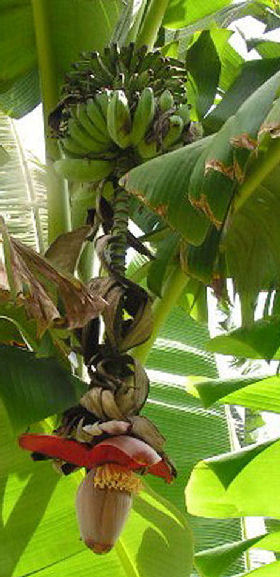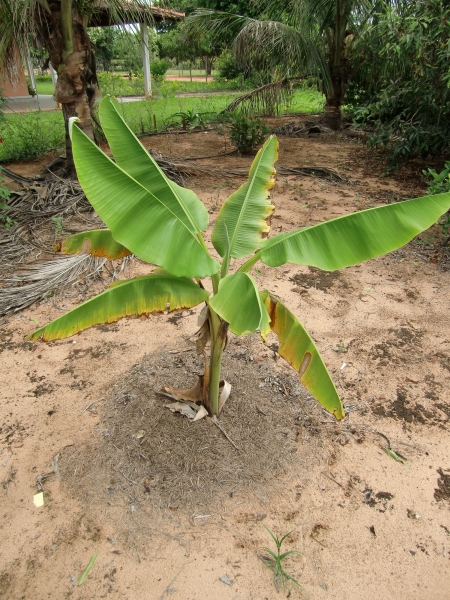

Musa balbisiana
Wild Cook Banana, Wild Plantain, Genuine Japanese Fiber Banana
That is the ancestor of the fruit bananas of the section Musa, from crossings with Musa acuminata the today's modern fruit bananas are developed. Above all cook bananas descend of it. It is resident in Northern India, China (in all probability also Yunnan) and Southeast Asia, in Southern Japan it is cultivated for the fiber production. Their hardiest provenances should be nearly as hardy as Musa basjoo, so between Musa basjoo and sikkimensis. This means, they are suitable for USDA zone 8. There are also outdoor sites even in Germany, one of them in the botanical garden in Cologne, which is called there “Kölner Flora”, where it is overwintered exactly like Musa basjoo outdoors!
The specimen of Musa balbisiana in the Kölner Flora shows rich bluish white waxed pseudotrunks and bluish leaves with reddish leaf lower surfaces.
To get the optimal hardiness, only the hardiest provenances should be picked, of all the Northern Indian provenances from the Himalayan Mountains and the Chinese mountain provenances too. And they should be outplanted only as older plants with suckers and partly woody corms. The hardiness is variable between different provenances, the tropical southeastern Asian provenances might be less hardy, these also are seen sometimes on the Canary Islands on public places and parks, in Puerto de la Cruz this species is also seen in the botanical garden.
The plant grows over 15 feet (4,50 meters) tall, in Germany and other colder areas probably some smaller. It forms many suckers and can be propagated easily through this. The fruits look nearly like the fruit bananas, but they are full of seeds and inedible. Our plants are grown from seed by Frutas Raras, three of them Helton Josué brought to me on 16th September 2009, best thanks to him and his wife Emilene.
However the sandy soil is not well suitable because of the lack of nutrients and of the too fast heating, I have transplanted one of the plants to the pond in December 2010, where also Musa 'Nanica' grew very well and the soil stays moist during the drought time because of the higher ground water level, and also already fruited. In Angatuba in the nursery of Colecionando Frutas stands one huge specimen, this species thrives in Brazil very well.
The species could be crossed with Musa basjoo and sikkimensis.
 |
 |
| Musa balbisiana in Puerto de la Cruz/Teneriffa/Kanarische Inseln (Foto: Joachim Jäck) | Fruchtstand mit männlichen Blüten (Foto: Gabriel Sachter-Smith/USA) |

Musa balbisiana in our garden in December 2009.

Musa
balbisiana grown from seed from Rarepalmseeds
in the nursery
of Colecionando Frutas of
Helton Josué in Angatuba late October 2012.
Updated by Joachim Jaeck on October 10th, 2013